23 Types Of WHITE BIRDS (ID Guide With Photos)
Did you see a white bird recently? In that case you’ll probably want to know what species you saw.
Identifying birds that are largely white is not as easy as it might seem, since there are surprisingly many bird species in North America that fit this description.
To help you identify the bird you came across, we’ll cover all the white colored birds that can be seen in North America.
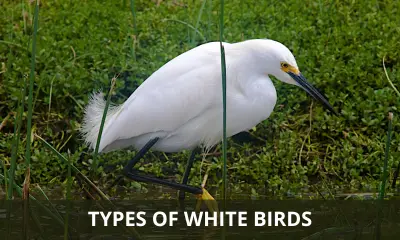
What are the different types of white birds in North America?
There are 23 different types of white birds in North America, which are covered in full detail below.
Great Egret
Scientific name: Ardea alba
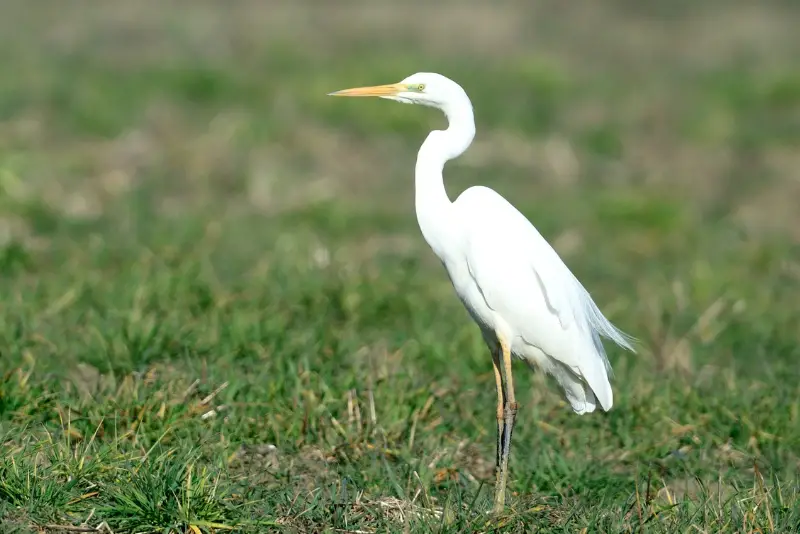
The Great Egret has a range that spans nearly the whole planet, and can be found on almost all continents.
This heron is a big, pure white bird, except for its long black legs and feet along with a thick, yellow beak.
During the spring and summer breeding seasons, the Great Egret grows a plume on its back that extends all the way to the tip of its tail.
These white herons forage in any type of shallow water, including ponds, lakes, rivers, estuaries, as well as rice fields and other flooded areas.
Snowy Egret
Scientific name: Egretta thula
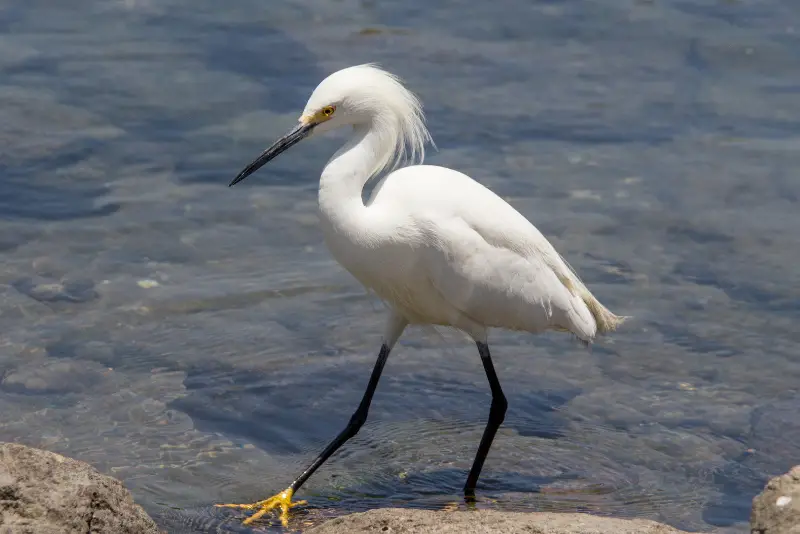
The Snowy Egret has become an increasingly common breeding bird all over the southern United States.
This is due to aggressive conservation efforts that were necessary because this Egret species was systematically hunted in previous centuries.
This little white egret stands out due to its slim black bill and bright area between the eyes and nostrils.
In adult birds, the feet are a brilliant golden yellow, while the legs are totally black. It is thought that the brightly colored feet help to attract small fish and other prey.
Cattle Egret
Scientific name: Bubulcus ibis
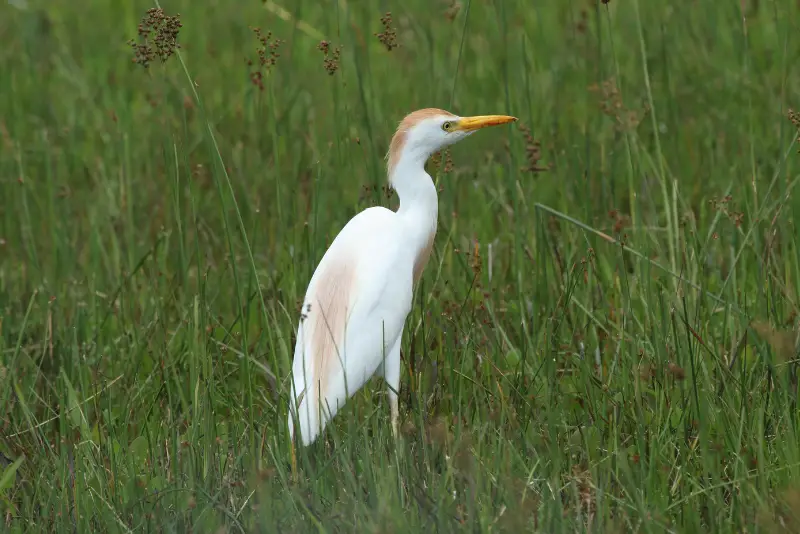
The Cattle Egret is a relatively new species in the New World that originated in Europe and Africa.
Nobody knows how these birds crossed the Atlantic, but they were first discovered breeding in Brazil, and later in Florida, where these birds first appeared in late 1955.
Cattle Egrets have been very successful at colonizing the Americas, and are now common breeding birds all over the southern United States.
This is a small egret that is entirely white, except for the breeding season, when adults develop orange plumage on the back of their head, back, and chest.
White Ibis
Scientific name: Eudocimus albus
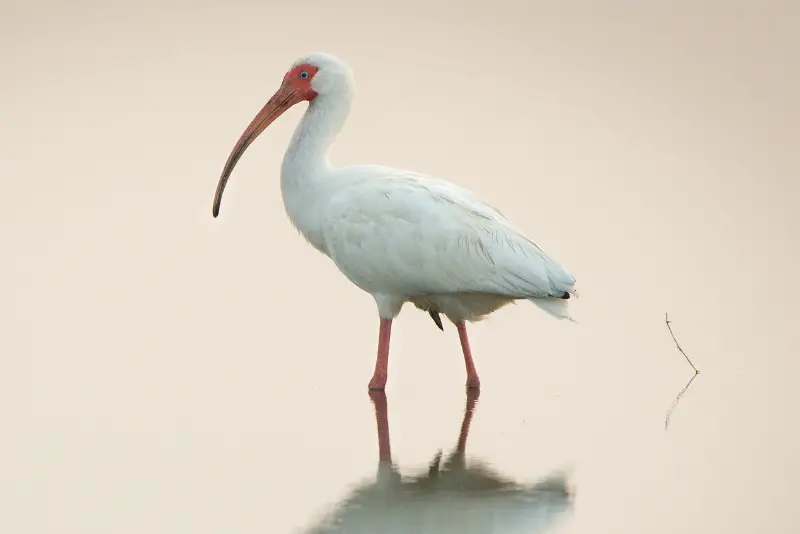
This white species is easy to recognize due to its generally white plumage and long vividly orange colored beak that is curved downwards.
During the first two years of their lives, immature White Ibises have a chocolate brown body with light streaks and a pale orange beak.
While it is most commonly found in coastal areas, the American White Ibis prefers to forage in freshwater habitats.
This bird feeds on fish, insects, crayfish, and other crustaceans. Crayfish form a large part of its diet in areas where they are common.
Wood Stork
Scientific name: Mycteria americana
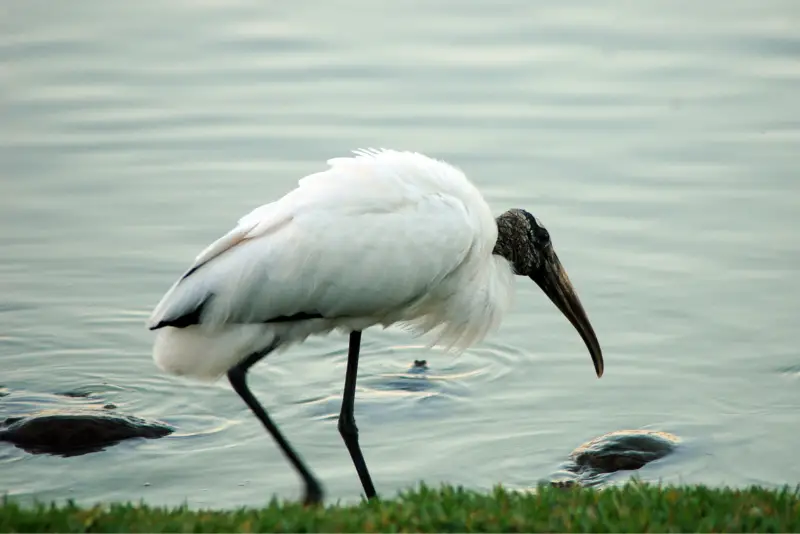
It’s easy to identify a Wood Stork if you can see it up close, due to its entirely white body combined with a bald, black head.
Similar to the White Ibis, the Wood Stork has a bill that curves slightly downwards. However, in contrast to the White Ibis, the Wood Stork has a black bill.
The Wood Stork is a large bird, similar in size to a Great Egret, but is easily distinguishable from that species by its curved beak.
Unfortunately, Wood Stork populations have been in decline over the past decades, which is a trend that it shares with many other wading birds.
Whooping Crane
Scientific name: Grus americana
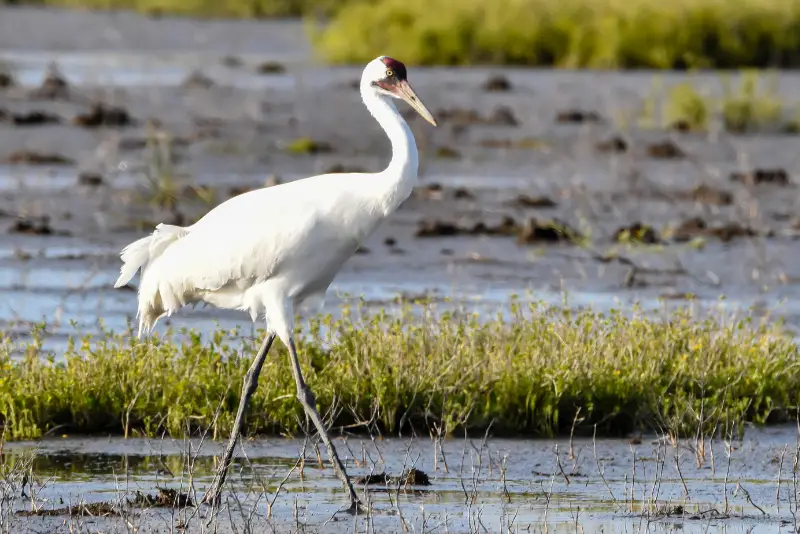
The Whooping Crane was a critically endangered species, and at the brink of extinction in the 1930s, with less than 20 birds remaining.
However, sustained conservation efforts have brought it back to a current population that numbers 600 birds.
Adult Whooping Cranes have a completely white body, with a red cap that consists of bare skin. In contrast to adults, juvenile birds have a reddish brown color.
Whooping Cranes breed in Alberta, Canada, as well as Wisconsin, and migrate south to spend the winter in southern states.
During the non-breeding season, the preferred habitat of Whooping Cranes are wetlands, marshes, estuaries, and salt flats.
American White Pelican
Scientific name: Pelecanus erythrorhynchos

The American White Pelican is one of the largest aquatic birds in North America, and is almost entirely white, except for its black wingtips and secondary feathers on its wings.
These birds breed in the northern US, and spend the winter along the Gulf Coast, as well as in Florida and California.
This is the largest white bird in North America
With a wingspan of up to 10 feet, and a body weight of up to 30 pounds in males, the American White Pelican is the biggest white bird in North America.
This bird feeds almost exclusively on fish, but unlike other pelican species it doesn’t dive in order to catch them. Instead it submerges its head down into the water, and grabs fish with its large beak.
Their preferred habitat are estuaries, shallow bays, and coastal inlets, as well as freshwater lakes further inland.
Snow Goose
Scientific name: Anser caerulescens
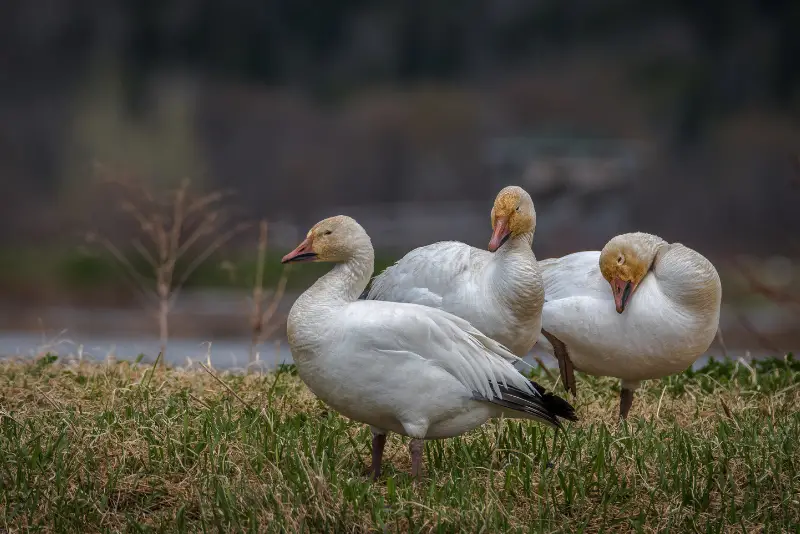
Similar to Trumpeter Swans, Snow Geese are winter visitors in the United States, but the number of wintering Snow Geese has rapidly increased in recent years.
The Snow Goose exists in two color morphs, one of which is entirely white, while the other is blue gray with a light cream head.
The Arctic population of Snow Geese has gone up significantly in the past few decades, and as result it is also much more common in its wintering grounds.
Snow Geese like to feed on harvested farmland, such as wheat fields, where these birds feed on leftover grains. In some cases these birds also forage on rice fields.
Trumpeter Swan
Scientific name: Cygnus buccinator
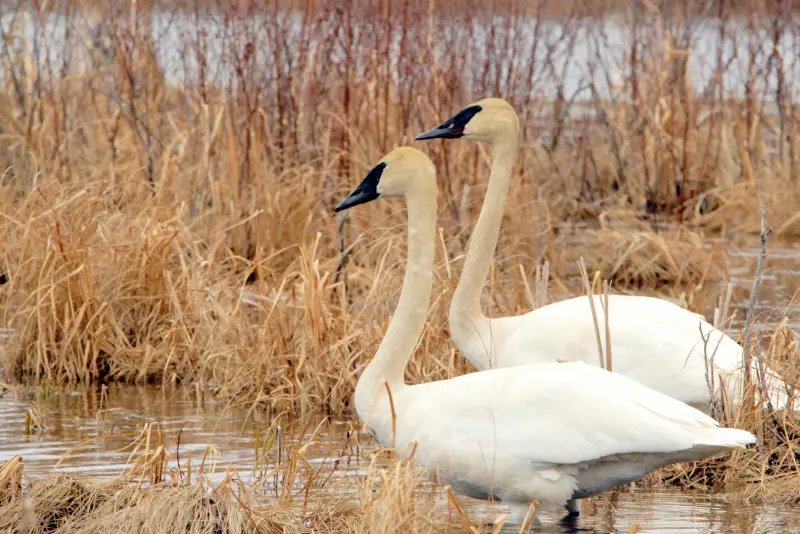
The Trumpeter Swan is a breeding bird of Canada and the northern United States, and is seen in the southern US as a rare winter visitor.
These huge white colored birds are among the largest waterfowl found in North America, and adults are entirely white with a black beak, as well as a black area of skin between the eye and the bill.
Trumpeter Swans prefer shallow freshwater habitats, where they can use their long neck to reach their preferred food: aquatic plants.
In some cases these large white water birds can also be seen foraging on rice fields or harvested farmland, where they feed on leftover grains.
Tundra Swan
Scientific name: Cygnus columbianus

The Tundra Swan is a large breeding bird of northern Canada and northern Alaska. It is a winter visitor along the East Coast, where it can be seen from October through March.
These beautiful white birds are among the largest waterfowl found in North America, and adults are entirely white with a black beak. They can be distinguished from Trumpeter Swans by the yellow area of skin between the eye and the bill.
In contrast to adults, juveniles are pale gray streaked with white. These white swans feed in shallow water, where they use their long neck to reach for mollusks and aquatic vegetation.
Similar to geese, Tundra Swans also feed on leftover grains on harvested farmland.
Mute Swan
Scientific name: Cygnus olor

The Mute Swan is not native to North America, but has established numerous breeding populations here after being imported from Europe in the 19th century.
And while these invasive water birds are often frowned upon by local birders (due to their aggressive nature, which is thought to disturb the local fauna and flora), there can be no doubt that they are among the most elegant birds on the planet.
Mute swans are very aggressive when defending their nest or chicks, and so you should give them a wide berth during the breeding season.
Laughing Gull
Scientific name: Leucophaeus atricilla
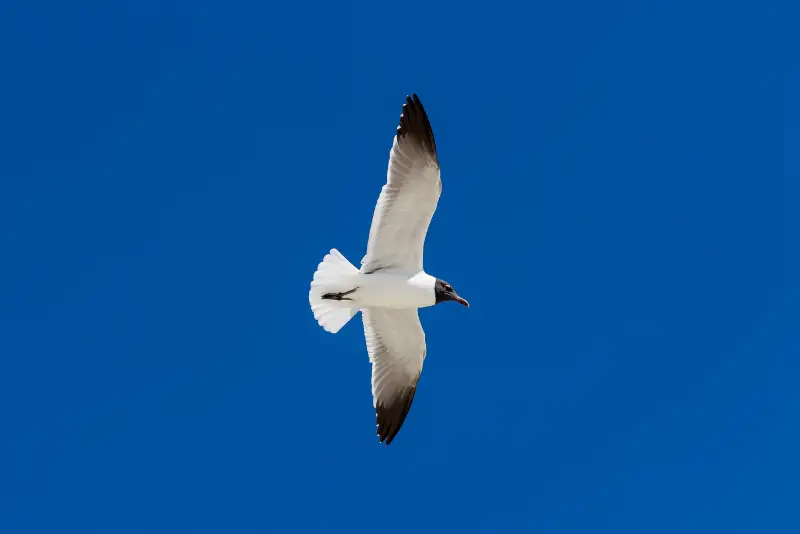
The Laughing Gull is common along the entire East Coast, and can be easily identified by its black head and its loud call that resembles human laughter.
Adult Laughing Gulls in summer have a white body with a black head and gray upperside. Both the bill and the legs are dark red. In contrast to adults, juvenile birds are pale gray brown.
Laughing Gulls are most common close to mud flats and sandy beaches, but these birds also occur away from land, foraging over open water.
Ring-billed Gull
Scientific name: Larus delawarensis
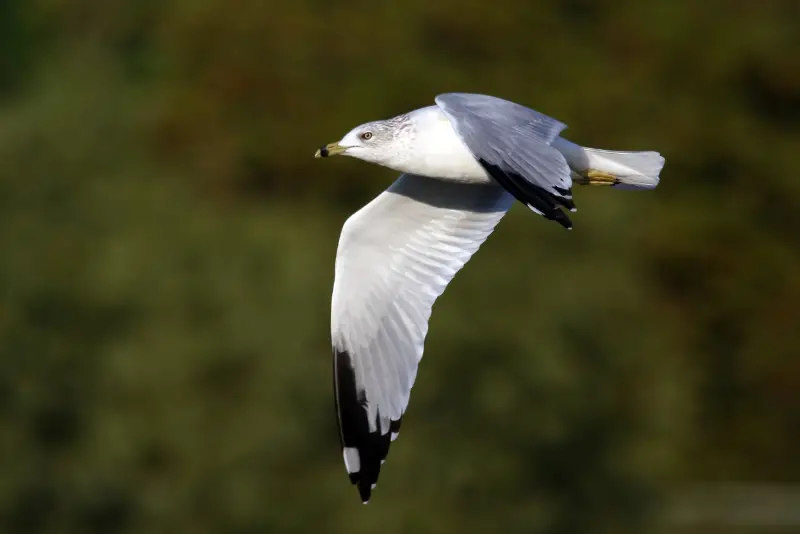
The Ring-billed gull is a breeding bird of northern North America, as well as a common winter visitor in southern states of the US.
Adults are almost entirely white, except for their light gray upperparts and black wing tips. The legs and the bill are bright yellow. Juvenile birds are more mottled in appearance, with a mix of brown and gray.
This bird can be confused with the Herring Gull, but the latter is more rare, while the Ring-billed Gull is quite common on large lakes and reservoirs.
Ivory Gull
Scientific name: Pagophila eburnea
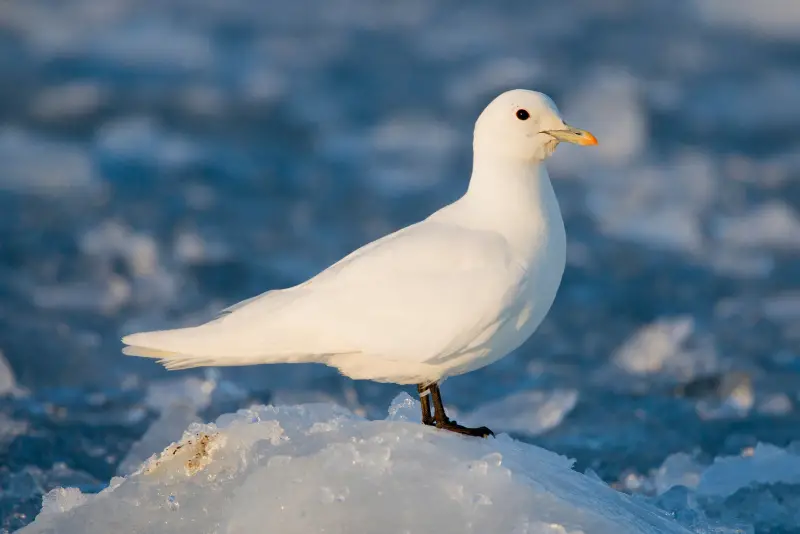
This gull is a bird of the high arctic, where it is often encountered in the company of polar bears, since it scavenges on their kills.
Adult Ivory Gulls have entirely white feathers, but if you see them close up, you’ll notice their dark legs and gray beak with a yellow tip.
In order to see this white seabird you’ll have to voyage up to the high arctic, although it shows up as a rare vagrant as far south as northern California.
Forster’s Tern
Scientific name: Sterna forsteri

The Forster’s Tern is a medium sized white tern that is a common breeding bird in the northern US, and winters along the coast of southern states.
Adult birds are almost entirely white, except for their gray mantle and black cap. Their orange beak has a black tip.
In its non-breeding plumage, it loses most of its black cap, but can be identified by a characteristic comma shaped black eye patch.
Caspian Tern
Scientific name: Hydroprogne caspia
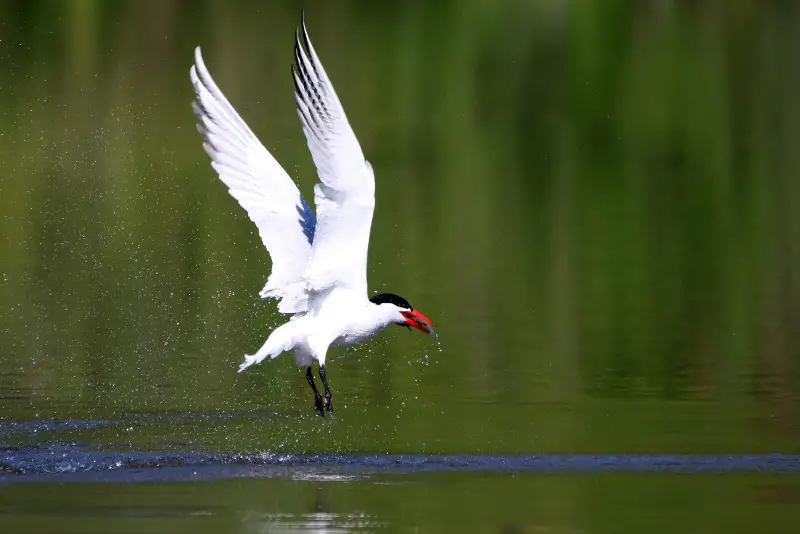
The Caspian tern is the largest tern species in the world. It is a breeding bird of northern North America, as well as a winter visitor in Florida, California, and the Gulf Coast.
It superficially resembles the Forster’s Tern, but it is a much larger bird and has a thicker bill, broader wings, and a less forked tail.
Also, during winter the Caspian Tern doesn’t lose its black cap completely, but always retains a streaked, dark crown.
The Caspian Tern breeds in freshwater habitats in Canada and northern USA, and winters in the Caribbean and the Gulf of Mexico.
Royal Tern
Scientific name: Sterna maxima
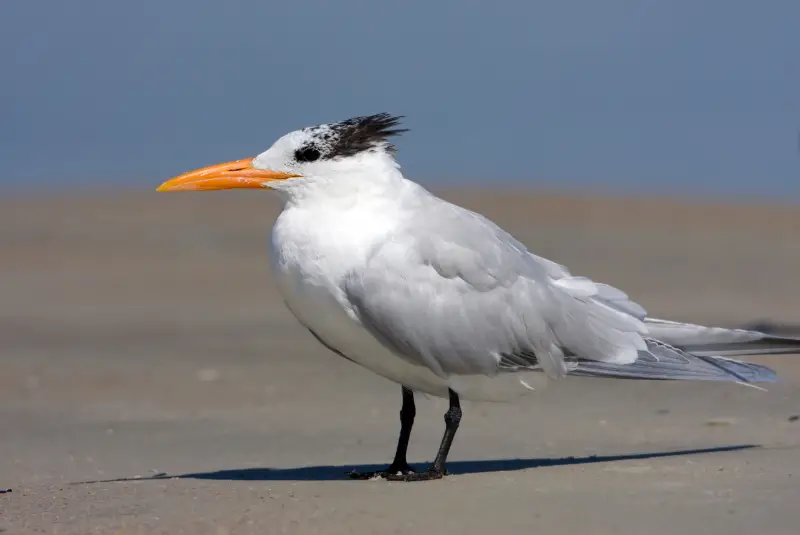
The Royal Tern is a breeding bird along the northern East Coast, and during the winter these birds are also found far south of their breeding grounds.
During the cold months, these beautiful birds can be seen along the entire Gulf Coast, where they hunt small fish by plunging head-first into the water.
Swallow-tailed Kite
Scientific name: Elanoides forficatus
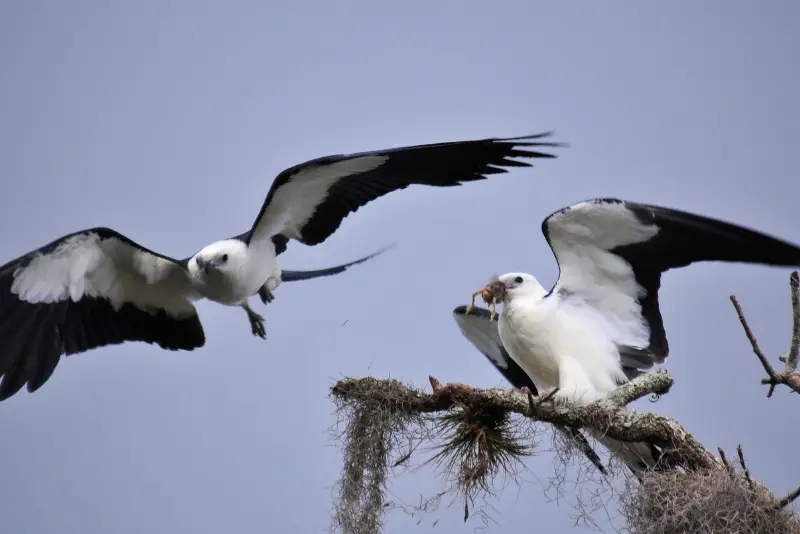
This elegant white bird of prey is easy to identify in flight, due to the combination of its bright underparts with its deeply forked tail.
The rear margins of the wings and the tail are black. When perched on a tree, its white head and chest contrast with the dark grayish black upperside.
Similar to other kite birds, this bird is a skilled hunter and capable of catching insects in flight. Its preferred food are small reptiles, rodents, and insects.
The Swallow-tailed Kite is a summer visitor in the southeastern United States, and migrates to Central and South America to spend the winter.
White-tailed Kite
Scientific name: Elanus leucurus

The White-tailed Kite is also known as the Black-shouldered Kite, and both of these are apt names for it.
Adult White-tailed Kites have an entirely white underside, head, and tail. Their upper side is light gray, with dark gray patches on the shoulders. The eyes are deep red.
These raptors hunt for small rodents, insects and reptiles in open grassland, either from a perch or on the wing.
They are scarce breeding residents along the West Coast, southern Texas, and southern Florida, where these birds can be seen year-round.
Related: What are the white birds of Florida?
Gyrfalcon
Scientific name: Falco rusticolus
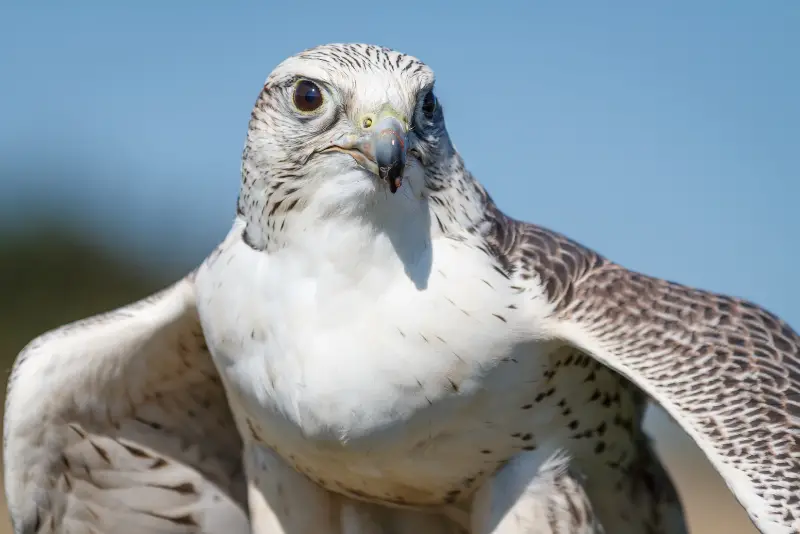
The Gyrfalcon is the largest falcon species in the world, and is significantly larger than a Peregrine Falcon.
It breeds in the high arctic tundra around the entire globe. This white falcon is not very common anywhere in the world, but its highest concentrations of breeding pairs are found in Alaska, northern Canada, and Greenland.
In their wintering grounds in the northern United States they are found in open landscapes, and hunt a wide variety of small and medium-sized birds and mammals.
Snowy Owl
Scientific name: Bubo scandiacus

Snowy Owls are very rare winter visitors in the United States, and are most likely to occur during irruptive years, when large numbers of Snowy Owls migrate south due to a shortage of suitable prey in their regular wintering grounds.
When these white owls show up, they are usually spotted in wide open fields, such as shorelines and grassland.
The Snowy Owl is the largest owl species in North America, and weighs more than the Great Horned Owl.
Snow Bunting
Scientific name: Plectrophenax nivalis
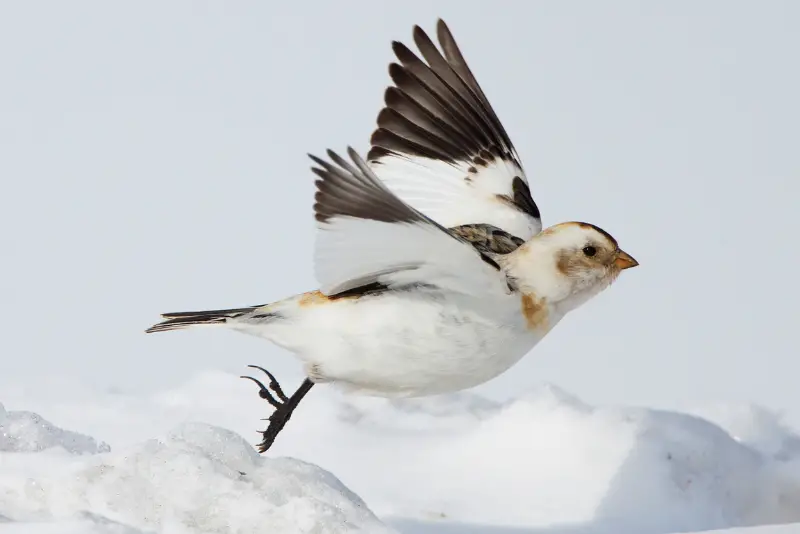
Snow Buntings are small songbirds that breed in the arctic tundra, but migrate south in winter, showing up in large flocks in southern Canada and the northern United States.
During the breeding season, males are mostly white, except for their black shoulders, wingtips, and tail feathers. Females are more drab, with a mix of grayish brown and dirty white.
During the winter, these small white birds acquire a more brownish white color, which helps them to blend in with their surroundings.
Rock Ptarmigan
Scientific name: Lagopus muta

The Rock Ptarmigan is another bird of the high arctic, and breeds in dry tundra along the coastal areas of northern Canada and Alaska.
During the winter they are entirely white, which provides excellent camouflage in snowy landscapes. They also have feathered toes, helping them to walk on top of the snow.
However, during the breeding season they molt and change into a mottled gray brown pattern, which in turn blends in with the summer tundra.
What are the types of large white birds in North America?
There are 11 types of large white-colored birds in North America, which are listed below:
- Great Egret
- Wood Stork
- Whooping Crane
- American White Pelican
- Trumpeter Swan
- Tundra Swan
- Mute Swan
- Caspian Tern
- White-tailed Kite
- Swallow-tailed Kite
- Snowy Owl
If you’re not sure which of these birds you’ve seen, or how to distinguish between them, check out the photos in our detailed ID guide above.
Final remarks
In summary, here are the 23 types of white-colored birds covered in this article:
- Great Egret
- Snowy Egret
- Cattle Egret
- White Ibis
- Wood Stork
- Whooping Crane
- American White Pelican
- Snow Goose
- Trumpeter Swan
- Tundra Swan
- Mute Swan
- Laughing Gull
- Ring-billed Gull
- Ivory Gull
- Forster’s Tern
- Caspian Tern
- Royal Tern
- Swallow-tailed Kite
- White-tailed Kite
- Gyrfalcon
- Snowy Owl
- Snow Bunting
- Rock Ptarmigan
If you’ve spotted one of these birds, but aren’t sure which species it was, check our detailed ID guide with photos above.
If you enjoyed this article, check out our guide to the white birds of Texas.
